Supervulkán Yellowstone
Super Volcano In Yellowstone National Park
Source: United States Geological Survey, University of Utah, The BBC

It is little known that lying underneath one of The United States largest and most picturesque National Parks - Yellowstone Park - is one of the largest "super volcanoes" in the world.

Eruptions of the Yellowstone volcanic system have included the two largest volcanic eruptions in North America in the past few million years; the third largest was at Long Valley in California and produced the Bishop ash bed. The biggest of the Yellowstone eruptions occurred 2.1 million years ago, depositing the Huckleberry Ridge ash bed. These eruptions left behind huge volcanic depressions called “calderas” and spread volcanic ash over large parts of North America (see map). If another large caldera-forming eruption were to occur at Yellowstone, its effects would be worldwide. Thick ash deposits would bury vast areas of the United States, and injection of huge volumes of volcanic gases into the atmosphere could drastically affect global climate. Fortunately, the Yellowstone volcanic system shows no signs that it is headed toward such an eruption in the near future. In fact, the probability of any such event occurring at Yellowstone within the next few thousand years is exceedingly low.
http://pubs.usgs.gov/fs/2005/3024
The term "supervolcano" has no specifically defined scientific meaning. It was used by the producers of The BBC TV show Horizion in 2000 to refer to volcanoes that have generated Earth's largest volcanic eruptions. As such, a supervolcano would be one that has produced an exceedingly large, catastrophic explosive eruption and a giant caldera.

Scientists evaluate natural-hazard levels by combining their knowledge of the frequency and the severity of hazardous events. In the Yellowstone region, damaging hydrothermal explosions and earthquakes can occur several times a century. Lava flows and small volcanic eruptions occur only rarely—none in the past 70,000 years. Massive caldera-forming eruptions, though the most potentially devastating of Yellowstone’s hazards, are extremely rare—only three have occurred in the past several million years. U.S. Geological Survey, University of Utah, and National Park Service scientists with the Yellowstone Volcano Observatory (YVO) see no evidence that another such cataclysmic eruption will occur at Yellowstone in the foreseeable future. Recurrence intervals of these events are neither regular nor predictable.
Scientists have revealed that Yellowstone Park has been on a regular eruption cycle of 600,000 years. The last eruption was 640,000 years ago…so the next is overdue. The next eruption could be 2,500 times the size of the 1980 Mount St. Helens eruption. Volcanologists have been tracking the movement of magma under the park and have calculated that in parts of Yellowstone the ground has risen over seventy centimeters this century.
Around the world there are several other volcanic areas that can be considered "supervolcanoes"- Long Valley in eastern California, Toba in Indonesia, and Taupo in New Zealand. Other "supervolcanoes" would likely include the large caldera volcanoes of Japan, Indonesia, Alaska (e.g. Aniakchak, Emmons, Fisher).

Normal volcanoes are formed by a column of magma - molten rock - rising from deep within the Earth, erupting on the surface, and hardening in layers down the sides. This forms the familiar cone shaped mountain we associate with volcanoes.

Supervolcanoes, however, begin life when magma rises from the mantle to create a boiling reservoir in the Earth's crust. This chamber increases to an enormous size, building up colossal pressure until it finally erupts. The explosion would send ash, dust, and sulfur dioxide into the atmosphere, reflecting the sun's rays and creating a cold wave lasting several years. Crops in many areas would fail and many species of animals and plants would face extinction.

Volcanic activity began in the Yellowstone National Park region a little before about 2 million years ago. Molten rock (magma) rising from deep within the Earth produced three cataclysmic eruptions more powerful than any in the world's recorded history. The first caldera-forming eruption occurred about 2.1 million years ago. The eruptive blast removed so much magma from its subsurface storage reservoir that the ground above it collapsed into the magma chamber and left a gigantic depression in the ground- a hole larger than the state of Rhode Island. The huge crater, known as a caldera, measured as much as 80 kilometers long, 65 kilometers wide, and hundreds of meters deep, extending from outside of Yellowstone National Park into the central area of the Park.
The most recent caldera-forming eruption about 650,000 years ago produced a caldera 53 x 28 miles (85 x 45 kilometers) across in what is now Yellowstone National Park (Figure 2). During that eruption, ground-hugging flows of hot volcanic ash, pumice, and gases swept across an area of more than 3,000 square miles. When these enormous pyroclastic flows finally stopped, they solidified to form a layer of rock called the Lava Creek Tuff. Its volume was about 240 cubic miles (1,000 cubic kilometers), enough material to cover Wyoming with a layer 13 feet thick or the entire conterminous United States with a layer 5 inches thick. The Lava Creek Tuff has been exposed by erosion at Tuff Cliff, a popular Yellowstone attraction along the lower Gibbon River.

The eruption also shot a column of volcanic ash and gases high into Earth's stratosphere. This volcanic cloud circled the globe many times and affected Earth's climate by reducing the intensity of solar radiation reaching the lower atmosphere and surface. Fine volcanic ash that fell downwind from the eruption site blanketed much of North America. This ash layer is still preserved in deposits as far away as Iowa, where it is a few inches thick, and the Gulf of Mexico, where it is recognizable in drill cores from the sea floor. Lava flows have since buried and obscured most of the caldera, but the underlying processes responsible for Yellowstone's tremendous volcanic eruptions are still at work.

ZDROJ:http://www.solcomhouse.com/yellowstone.htm
